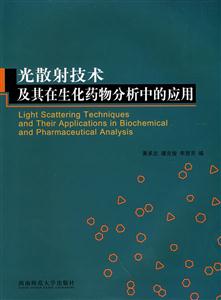-
>
宇宙、量子和人類心靈
-
>
氣候文明史
-
>
南極100天
-
>
考研數學專題練1200題
-
>
希格斯:“上帝粒子”的發明與發現
-
>
神農架疊層石:10多億年前遠古海洋微生物建造的大堡礁
-
>
聲音簡史
光散射技術及其在生化藥物分析中的應用 版權信息
- ISBN:9787562139836
- 條形碼:9787562139836 ; 978-7-5621-3983-6
- 裝幀:一般膠版紙
- 冊數:暫無
- 重量:暫無
- 所屬分類:>>
光散射技術及其在生化藥物分析中的應用 本書特色
光散射現象在自然界中廣泛存在,光散身分析化學是近年來的一個熱點研究領域,已成為分析科學的重要分支。《光散射技術及其在生化藥物分析中的應用》介紹了光散射分析技術的方法、原理及其在生物大分子、有機小分子和藥物中的分析應用,《光散射技術及其在生化藥物分析中的應用》可作為從事分子光譜分析工作的研究生以及相關領域的科研人員的參考書。
光散射技術及其在生化藥物分析中的應用 內容簡介
散射光產生于光子與微小粒子的相互作用。當光子作用于任何不均勻介質時,都有散射光產生。結合激光技術,散射光已在膠體化學、高分子化學等粒子大小表征和分子量測定方面得到了應用,但在吸收和發射(熒光)光譜分析中,散射光卻是嚴重的干擾因素。1993年,美國學者Pasternack及其合作者發現使用普通熒光光度計獲得的光散射信號可應用于生物色素聚集體研究。在此基礎上,我們把普通熒光光度計測定的光散射信號與物質的量聯系起來,建立了以散射發光為檢測信號的光譜分析法。近十年來,基于散射光信號的光譜分析法已為分析工作者廣泛應用于無機離子、蛋白質和核酸、藥物的9n,4定中,發展十分迅速,并隨著納米科學的發展取得了新成就。
作為近年來工作的總結,我們選編了本論文集。內容主要涉及到我攻讀博士學位期間完成的工作和我在西南大學所指導的研究生的論文。在此,感謝我的恩師北京大學童沈陽教授及其課題組的李克安教授、劉鋒教授、趙鳳林教授和李娜教授等的指導和幫助,感謝我的研究生們近年來為光散射分析所付出的努力,并希望他們在今后的工作中取得優異成績。
光散射技術及其在生化藥物分析中的應用 目錄
1.1 Resonance Light Scattering Technique Used for Biochemical and Pharmaceutical Analysis
1.2 The Principles and Analytical Applications of Total Internal Reflected Resonance Light Scattering Technique
1.3 Recent Developments of the Resonance Light Scattering Technique: Technical Evolution, New Probes and Applications
Chapter 2 Analytical Applications in DNA Detection of Light Scattering Technique
2.1 Determination of Nucleic Acids by a Resonance Light-scattering Technique with α,β,γ,δ-tetrakis [4-(trimethylammoniumyl)phenyl]Porphine
2.2 Hybridization Detection of DNA by Measuring Organic Small Molecule Amplified Resonance Light Scattering Signals
2.3 Determination of Nanograms of Nucleic Acids by their Enhancement Effect on the Resonance Light Scattering of the Cobalt(II)/4-[(5-chloro -2-pyridyl) azo]-1,3-diaminobenzene complex
2.4 Interactions of Janus Green B with Double Stranded DNA and the Determination of DNA Dased on the Measurement of Enhanced Resonance Light Scattering
2.5 A Sensitive and Selective Assay of Nucleic Acids by Measuring Enhanced Total Internal Reflected Resonance Light Scattering Signals Deriving from the Evanescent Field at the Water/Tetrachloromethane Interface
2.6 Backscattering Light Detection of Nucleic Acids with Tetraphenylporphyrin-Al(III)-Nucleic Acids at Liquid/Liquid Interface
2.7 Directly Light Scattering Imaging of the Aggregations of Biopolymer Bound Chromium(Ill) Hydrolytic Oligomers in Aqueous Phase and Liquid/Liquid Interface
Chapter 3 Analytical Applications in Protein Detection of Light Scattering Technique
3.1 Determination of Protein Concentration by Enhancement of the Preresonance Light-scattering
of α,β,γ,δ-tetrakis(5-sulfothienyl) Porphine
3.2 On the Factors Affecting the Enhanced Resonance Light Scattering Signals of the Interactions Between Proteins and Multiply Negatively Charged Chromophores Using Water Blue as an Example
3.3 Determination of Proteins with a;fl,),,rtetrakis(4-sulfophenyl) Porphine by Measuring the Enhanced Resonance Light Scattering at the Air/Liquid Interface
3.4 A Backscattering Light Detection Assembly for Sensitive Determination of Analyte Concentrated at the Liquid/Liquid Interface Using the Interaction of Quercetin with Proteins as the Model System
3.5 Flow-injection Resonance Light Scattering Detection of Proteins at the Nanogram Level
3.6 Resonance Light Scattering Imaging Detection of Proteins with α,β,γ,δ-tetrakis (p-sulfophenyl) Porphyrin
Chapter 4 Analytical Applications in Organic Mieromolecles and Medicines Detection of Light Scattering Technique
4.1 Enhanced Plasmon Resonance Light Scattering Signals of Colloidal Gold Resulted from its Interactions with Organic Small Molecules Using Captopril as an Example
4.2 Total Internal Reflected Resonance Light Scattering Determination of Chlortetracycline in Body Fluid with the Complex Cation of Chlortetracycline-europium-trioctyl Phosphine Oxide at the water/tetrachloromethane interface
4.3 Novel Assay of Thiamine Based on its Enhancement of Total Internal Reflected Resonance Light Scattering Signals of Sodium Dodecylbenzene Sulfonate at the Water/Tetrachloromethane Interface
4.4 Adsorption of Penicillin-berberine Ion Associates at a Water/Tetrachloromethane Interface
and Determination of Penicillin Based on Total Internal-reflected Resonance Light Scattering Measurements
4.5 Pharmacokinetic Detection of Penicillin Excreted in Urine using a Totally Internally Reflected Resonance Light Scattering Technique with Cetyltrimethylammonium Bromide
4.6 A Wide Dynamic Range Detection of Biopolymer Medicines with Resonance Light Scattering and Absorption Ratiometry
4.7 A resonance Light Scattering Ratiometry Applied for Binding Study of Organic Small Molecules with Biopolymer
4.8 A Light Scattering and Fluorescence Emission Coupled Ratiometry Using the Interaction of Functional. CdS Quantum Dots with Aminoglycoside Antibiotics as a Model System
4.9 Resonance Light Scattering Imaging Determination of Heparin
4.10 Visual Detection of Sudan Dyes Based on the Plasmon Resonance Light Scattering Signals of Silver Nanoparticles
- >
月亮虎
- >
詩經-先民的歌唱
- >
羅庸西南聯大授課錄
- >
推拿
- >
龍榆生:詞曲概論/大家小書
- >
有舍有得是人生
- >
羅曼·羅蘭讀書隨筆-精裝
- >
煙與鏡

















